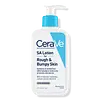What's inside
What's inside
 Key Ingredients
Key Ingredients

 Benefits
Benefits

 Concerns
Concerns

 Ingredients Side-by-side
Ingredients Side-by-side

Salicylic Acid
MaskingWater
Skin ConditioningGlycerin
HumectantParaffinum Liquidum
EmollientTriethanolamine
BufferingGlyceryl Stearate
EmollientAmmonium Lactate
BufferingPEG-100 Stearate
Cetearyl Alcohol
EmollientCetyl Alcohol
EmollientZea Mays Oil
EmulsifyingCeramide NP
Skin ConditioningCeramide AP
Skin ConditioningCeramide EOP
Skin ConditioningCarbomer
Emulsion StabilisingBehentrimonium Methosulfate
Dimethicone
EmollientMethylparaben
PreservativeSodium Lauroyl Lactylate
EmulsifyingCholecalciferol
Cholesterol
EmollientDisodium EDTA
Propylparaben
PreservativeHydrolyzed Hyaluronic Acid
HumectantPhytosphingosine
Skin ConditioningXanthan Gum
EmulsifyingSalicylic Acid, Water, Glycerin, Paraffinum Liquidum, Triethanolamine, Glyceryl Stearate, Ammonium Lactate, PEG-100 Stearate, Cetearyl Alcohol, Cetyl Alcohol, Zea Mays Oil, Ceramide NP, Ceramide AP, Ceramide EOP, Carbomer, Behentrimonium Methosulfate, Dimethicone, Methylparaben, Sodium Lauroyl Lactylate, Cholecalciferol, Cholesterol, Disodium EDTA, Propylparaben, Hydrolyzed Hyaluronic Acid, Phytosphingosine, Xanthan Gum
Sodium C14-16 Olefin Sulfonate
CleansingLauryl Betaine
CleansingSodium Chloride
MaskingGlycerin
HumectantDipropylene Glycol
HumectantTetradecene
Emollient1,2-Hexanediol
Skin ConditioningHydroxyacetophenone
AntioxidantPolyquaternium-10
Citric Acid
BufferingHexadecene
SolventTetrasodium EDTA
Butylene Glycol
HumectantCoffea Arabica Seed Extract
MaskingXylitylglucoside
HumectantPentylene Glycol
Skin ConditioningAnhydroxylitol
HumectantXylitol
HumectantLactobacillus Ferment Lysate
Skin ConditioningBifida Ferment Lysate
Skin ConditioningStreptococcus Thermophilus Ferment
HumectantSodium Hyaluronate
HumectantGlucose
HumectantOenothera Biennis Flower Extract
AstringentEel Extract
HumectantUlmus Davidiana Root Extract
Skin ConditioningPinus Palustris Leaf Extract
TonicPueraria Lobata Root Extract
HumectantSodium Hyaluronate Crosspolymer
HumectantHydrolyzed Hyaluronic Acid
HumectantHydrogenated Lecithin
EmulsifyingHyaluronic Acid
HumectantButyrospermum Parkii Butter
Skin ConditioningEthylhexylglycerin
Skin ConditioningHydrolyzed Sodium Hyaluronate
Skin ConditioningCeramide NP
Skin ConditioningParfum
MaskingSodium C14-16 Olefin Sulfonate, Lauryl Betaine, Sodium Chloride, Glycerin, Dipropylene Glycol, Tetradecene, 1,2-Hexanediol, Hydroxyacetophenone, Polyquaternium-10, Citric Acid, Hexadecene, Tetrasodium EDTA, Butylene Glycol, Coffea Arabica Seed Extract, Xylitylglucoside, Pentylene Glycol, Anhydroxylitol, Xylitol, Lactobacillus Ferment Lysate, Bifida Ferment Lysate, Streptococcus Thermophilus Ferment, Sodium Hyaluronate, Glucose, Oenothera Biennis Flower Extract, Eel Extract, Ulmus Davidiana Root Extract, Pinus Palustris Leaf Extract, Pueraria Lobata Root Extract, Sodium Hyaluronate Crosspolymer, Hydrolyzed Hyaluronic Acid, Hydrogenated Lecithin, Hyaluronic Acid, Butyrospermum Parkii Butter, Ethylhexylglycerin, Hydrolyzed Sodium Hyaluronate, Ceramide NP, Parfum
 Reviews
Reviews

Ingredients Explained
These ingredients are found in both products.
Ingredients higher up in an ingredient list are typically present in a larger amount.
Ceramide NP is a type of ceramide.
Ceramides are intercellular lipids naturally found in our skin that bonds dead skin cells together to create a barrier. They are known for their ability to hold water and thus are a great ingredient for dry skin.
Ceramides are an important building block for our skin barrier. A stronger barrier helps the skin look more firm and hydrated. By bolstering the skin ceramides act as a barrier against irritating ingredients. This can help with inflammation as well.
If you would like to eat ceramides, sweet potatoes contain a small amount.
Read more about other common types of ceramides here:
Ceramide AP
Ceramide EOP
Glycerin is already naturally found in your skin. It helps moisturize and protect your skin.
A study from 2016 found glycerin to be more effective as a humectant than AHAs and hyaluronic acid.
As a humectant, it helps the skin stay hydrated by pulling moisture to your skin. The low molecular weight of glycerin allows it to pull moisture into the deeper layers of your skin.
Hydrated skin improves your skin barrier; Your skin barrier helps protect against irritants and bacteria.
Glycerin has also been found to have antimicrobial and antiviral properties. Due to these properties, glycerin is often used in wound and burn treatments.
In cosmetics, glycerin is usually derived from plants such as soybean or palm. However, it can also be sourced from animals, such as tallow or animal fat.
This ingredient is organic, colorless, odorless, and non-toxic.
Glycerin is the name for this ingredient in American English. British English uses Glycerol/Glycerine.
Learn more about GlycerinHydrolyzed Hyaluronic Acid is a form of hyaluronic acid. It is created by the hydrolysis of hyaluronic acid with a high molecular weight. Once created, Hydrolyzed Hyaluronic Acid has a low molecular weight.
Low molecular weight HA has been shown to hydrate and increase elasticity of the skin. Increasing elasticity is also associated with reduction of wrinkle depth.
One study found topical low molecular weight hyaluronic acid may be considered for the treatment of rosacea in the adult population. However, we always recommend speaking with a professional about your skin concerns.
Hyaluronic acids are a humectant. This means they draw moisture from the air. Hyaluronic acids help moisturize, soothe, and protect the skin.
Read more about other common forms of hyaluronic acid:
Learn more about Hydrolyzed Hyaluronic Acid